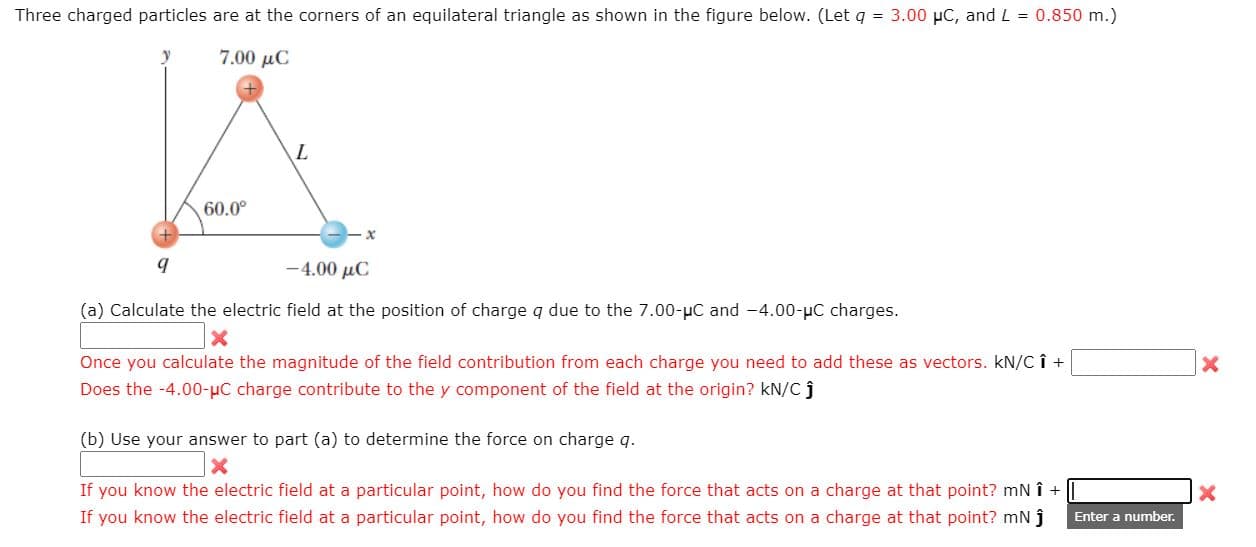Three charged particles are at the corners of an equilateral triangle as shown in the figure below. (Letq = 3.00 µC, and L = 0.850 m.) 7.00 µC 60.0° -4.00 μC (a) Calculate the electric field at the position of charge q due to the 7.00-uC and -4.00-uC charges. Once you calculate the magnitude of the field contribution from each charge you need to add these as vectors. kN/C î + Does the -4.00-µC charge contribute to the y component of the field at the origin? kN/C j (b) Use your answer to part (a) to determine the force on charge q. If you know the electric field at a particular point, how do you find the force that acts on a charge at that point? mN î + If you know the electric field at a particular point, how do you find the force that acts on a charge at that point? mN j Enter a number.
Three charged particles are at the corners of an equilateral triangle as shown in the figure below. (Letq = 3.00 µC, and L = 0.850 m.) 7.00 µC 60.0° -4.00 μC (a) Calculate the electric field at the position of charge q due to the 7.00-uC and -4.00-uC charges. Once you calculate the magnitude of the field contribution from each charge you need to add these as vectors. kN/C î + Does the -4.00-µC charge contribute to the y component of the field at the origin? kN/C j (b) Use your answer to part (a) to determine the force on charge q. If you know the electric field at a particular point, how do you find the force that acts on a charge at that point? mN î + If you know the electric field at a particular point, how do you find the force that acts on a charge at that point? mN j Enter a number.
Principles of Physics: A Calculus-Based Text
5th Edition
ISBN:9781133104261
Author:Raymond A. Serway, John W. Jewett
Publisher:Raymond A. Serway, John W. Jewett
Chapter19: Electric Forces And Electric Fields
Section: Chapter Questions
Problem 75P: A solid, insulating sphere of radius a has a uniform charge density throughout its volume and a...
Related questions
Question

Transcribed Image Text:Three charged particles are at the corners of an equilateral triangle as shown in the figure below. (Letq = 3.00 µC, and L = 0.850 m.)
7.00 µC
60.0°
-4.00 μC
(a) Calculate the electric field at the position of charge q due to the 7.00-uC and -4.00-uC charges.
Once you calculate the magnitude of the field contribution from each charge you need to add these as vectors. kN/C î +
Does the -4.00-µC charge contribute to the y component of the field at the origin? kN/C j
(b) Use your answer to part (a) to determine the force on charge q.
If you know the electric field at a particular point, how do you find the force that acts on a charge at that point? mN î +
If you know the electric field at a particular point, how do you find the force that acts on a charge at that point? mN j
Enter a number.
Expert Solution
This question has been solved!
Explore an expertly crafted, step-by-step solution for a thorough understanding of key concepts.
This is a popular solution!
Trending now
This is a popular solution!
Step by step
Solved in 5 steps with 7 images

Knowledge Booster
Learn more about
Need a deep-dive on the concept behind this application? Look no further. Learn more about this topic, physics and related others by exploring similar questions and additional content below.Recommended textbooks for you

Principles of Physics: A Calculus-Based Text
Physics
ISBN:
9781133104261
Author:
Raymond A. Serway, John W. Jewett
Publisher:
Cengage Learning

Physics for Scientists and Engineers, Technology …
Physics
ISBN:
9781305116399
Author:
Raymond A. Serway, John W. Jewett
Publisher:
Cengage Learning

Physics for Scientists and Engineers: Foundations…
Physics
ISBN:
9781133939146
Author:
Katz, Debora M.
Publisher:
Cengage Learning

Principles of Physics: A Calculus-Based Text
Physics
ISBN:
9781133104261
Author:
Raymond A. Serway, John W. Jewett
Publisher:
Cengage Learning

Physics for Scientists and Engineers, Technology …
Physics
ISBN:
9781305116399
Author:
Raymond A. Serway, John W. Jewett
Publisher:
Cengage Learning

Physics for Scientists and Engineers: Foundations…
Physics
ISBN:
9781133939146
Author:
Katz, Debora M.
Publisher:
Cengage Learning

Physics for Scientists and Engineers
Physics
ISBN:
9781337553278
Author:
Raymond A. Serway, John W. Jewett
Publisher:
Cengage Learning

Physics for Scientists and Engineers with Modern …
Physics
ISBN:
9781337553292
Author:
Raymond A. Serway, John W. Jewett
Publisher:
Cengage Learning

College Physics
Physics
ISBN:
9781305952300
Author:
Raymond A. Serway, Chris Vuille
Publisher:
Cengage Learning